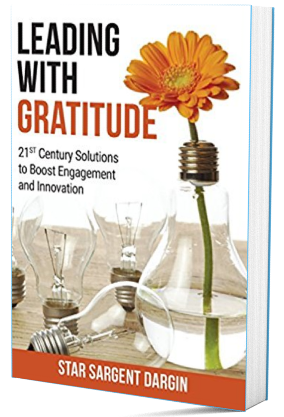Leaders are as unique as grains of sand. Eight billion people multiplied by millions of unique situations create many ways to lead. You choose what you want: lead, follow, ignore, or actively oppose each situation.
Leadership expert Warren Bennis states that there are more than 850 definitions of leadership academically. HR Trend Institute says there are a hundred leadership models. Amazon has over 60,000 books on leadership.
When you can answer your Five W’s (who, what, why, when, where), it creates your unique leadership framework; this framework will guide and help you chart your course forward. Forward can be towards a clear endpoint or baby steps when there is a lot of complexity and uncertainty. This framework may include or be like those 850 leadership definitions or hundreds of models. Gaining clarity on your five W’s helps you determine if you want to act as a leader in a situation, a follower, or a runaway! It’s a holistic approach to your journey in life.
The more grateful you are, the more self-aware you become. To build your situational leadership self-awareness, try using the Five W’s (who, what, where, when, why) to build your leadership self-awareness. The Five W’s is a tool I sometimes use at the start of a coaching engagement or workshop.
If you choose to take a leadership role, the Five W’s, 5W, framework will make setting a direction, crafting your messages, and acting faster easier. It’s a framework for handling uncertainty and the unknown.
WHO am I as a leader? 
Who you are determines what and how you will lead.
There is an “I” in leadership and no “I” in teams. A leader has followers. The followers may be small intimate teams or devoted individuals or groups from afar. Getting clarity on who you are will help create the boundaries and to balance the integration of you and your followers.
Oprah and Steve Jobs are known as international leaders in their respective fields. Their original leadership style was diametrically opposite. Yet, both commanded and changed industries and amassed billions of dollars. Now imagine Steve Jobs chatting with Oprah’s buddies, Gayle King, Suzie Orman, and Dr. Phil. Not a pretty picture in my mind. Many of Oprah’s and Steve Jobs’ leadership styles are based on who they are. Neither had a rule book on creating the industries they were involved in. They used who they are – their personal vision, beliefs, and values – to lead the way forward. Getting clear on who you are as a leader will serve as a baseline for moving into the uncertain and the unknown.
As a leader develops, observing and learning, and sometimes even mimicking other leaders or leadership models, is beneficial. However, when individuals apply their framework to situations, it is more sustainable, and they have a higher potential for success.
Exercise to get clarity on your vision, beliefs, and values, and answer this question regularly:
- Who are you?
- Where are you going?
- Why are you going there?
WHAT is the situation for me and others (teams, organizations, companies, industries, communities, and country)? What am I committed to doing, and how will I do it?
I am curious about what leaders do, how they do it, and what tools they use. I am a confessed leadership junkie. Teaching leadership workshops, I have at least twenty leadership models ready to go and pull them out based on what I perceive about my audience. I learned that not all are open to all leadership models. In her book Leadership and the New Science, Margaret Wheatley views organizations as living beings that are constantly growing and changing. She believes in self-managed teams. This idea can be repulsive to highly regulated, hierarchical, and control-based groups, yet non-profits with fewer resources often welcome it with open arms.
Management by Wandering around, MBW took on a new practical application with Covid. Virtual office hours and team drop-in virtual rooms became popular.
My leadership lessons have come from many situations, including outright failures and flops to a formal, year-long, top-performer corporate leadership program. Grace Hopper was one of the first women programmers and a Rear Admiral in the Navy, and the way she sums up leadership has been my approach: “If it’s a good idea, go ahead and do it. It’s much easier to apologize than it is to get permission.”
When you can answer the question “What is the situation,” then you can answer the question “What do we need for leadership here and now.” The situation will shape what is needed for leadership. An emergency needs decisive, directive, trusting, and caring leadership. The technology industry needs a leadership style that supports innovation. Highly regulated industries need leadership that controls and allows employee engagement. The leadership may change over time and vary by situation, and an almost limitless set of resources can be applied and adapted to meet your unique situation.
Exercise: In this situation, what is never, should, could, and would be great?
WHY is this happening now?
The question “why” creates context and allows for discovering the root cause of a problem. The root cause is a sustainable and underlying solution, not a temporary fix.
An organization became financially successful by providing technically advanced products. The company culture was based on independent, brilliant, and competitive superstar programmers. Over time the customers demanded more stable products and predictable releases. An internal rebellion occurred; maintaining code was not what the superstars signed up for. The leadership and culture remained unchanged until one leader could communicate what was happening and why. This leader gave context and spread the idea of success and the type of culture that was needed, a more collaborative one to support the new situation—saying why gave everyone an understandable context for essential conversations and determining appropriate action. People want to be seen and understood. Knowing the “why” in this situation allowed for a broader perspective and helped create empathy for those caught up in a change. Having this perspective, knowing “why” made it easier to handle the situation for both the business and the individual needs.
When the original superstar engineers understood why things were changing, they were better equipped to make a choice. They had a choice to leave the company or stay, hold on to their old ways with limited future success, or learn how to work collaboratively.
Ask: Why is this situation happening right now? Get to the root cause hy as much as possible. Try asking “why” 5 times.
WHEN is the best time for me to step into being a leader and act?
Answering these questions using your WHO (vision, beliefs, and values)
- Is this one of my most important areas to focus on?
- What does the situation need now or in the future?
- What role might I take? (Leader, follower, ignore, oppose)
- Is someone else better suited for the situation?
WHERE is the best physical or virtual place to be, to send a message, and to act?
It’s all about the people that are part of moving this forward. There will be champions, those who agree and will encourage you. There will be supporters who can do something to move you forward. Sometimes there are sponsors, those who can pay or pave the way for you. There will be detractors, those who actively resist, and those who ignore you. Identify who they are, their persona, and their demographics. Learn where they show up and when. When you are clear on who and where they are, you can answer where.
Figuring out where my job was in 2000 led to liquidating my parent’s estate. They both passed away within three weeks of each other, right before Covid started. They had hundreds of years of stuff accumulated from their old New England families in a large lakefront house. The items ranged from 2 tons of dumpster material to high-end auction and auctioneers with international audiences. I quickly learned who wanted to buy an 1883 Chicago World’s Fair Booth Exhibitor’s original signed booth agreement, a 25-year-old modified lake pontoon boat, to costume jewelry and dress from the 1920 and where they were—the pontoon boat sold on Craig’s list. The World Fair item on eBay and the costume jewelry were bought by a local collector I found on a local group.
Summary
The Five W’s 5W is a leadership tool that provides clarity and allows for positive movement.
The 5W’s are your inner compass. Use them to guide you through any situation. It doesn’t answer what skills you should have or what direction to take next. It doesn’t create strategies or plans. The 5W’s are a living, dynamic framework that grows with you as a leader. Creating your 5W leadership framework makes knowing what skills are needed, strategies, and planning easier and clearer.
The framework is your energy, your compass, so you can move and chart the best journey forward for you at any point and time.
References
How many leadership models are there? Nearly 100 Leadership Models – HR Trend Institute
How many leadership definitions are there? With Over 800 Definitions For Leadership, Here Are 5 You Need To Know And Why (forbes.com)
Sargent Estate Sale on Facebook, not active – Sargent Estate Sale | Facebook

